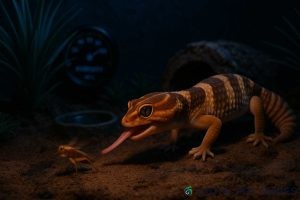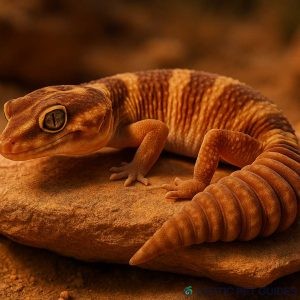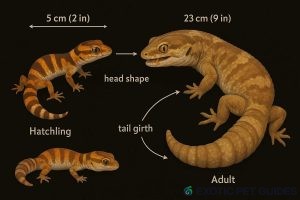A Beginner-Friendly Reptile with a Chunky Charm
Looking for a calm, easy-to-care-for reptile with a unique look? The African Fat-Tailed Gecko may be the perfect companion. Often overshadowed by its cousin, the Leopard Gecko, this species brings its own blend of personality, beauty, and low-maintenance care to the reptile hobby.
In this post, we’ll explore the origins, behavior, care requirements, and why African Fat-Tailed Geckos (AFTGs) are winning hearts in terrariums around the world.

🌍 Native Habitat
African Fat-Tailed Geckos hail from the dry savannas and scrublands of West Africa, particularly countries like Nigeria, Ghana, and Senegal. They live in burrows or under logs and rocks, where humidity is higher than the arid surface.
Unlike some desert-dwelling species, these geckos prefer moderate humidity and warmth, which makes them relatively easy to house with the right setup.
📏 Size and Appearance
- Length: 7 to 9 inches (including tail)
- Weight: 45 to 75 grams (adults)
- Lifespan: 10–15 years in captivity (some live longer with great care)
Key Features:
- A thick, rounded tail used for fat storage
- Smooth, velvety skin in shades of brown and cream
- Often features bold bands or stripes (some morphs lack them)
- Unlike Leopard Geckos, many AFTGs have eyelids, giving them a more expressive face
🧠 Temperament and Behavior
One of the best parts about Fat-Tailed Geckos? Their docile nature.
They are:
- Generally calm and slow-moving
- Tolerant of handling when done gently and regularly
- Nocturnal – most active at night and in the early morning
Because of their relaxed demeanor, AFTGs are perfect for beginners and reptile enthusiasts who prefer a more chill pet.
🏡 Housing and Habitat Setup
Enclosure
- Size: 20-gallon tank for one adult
- Substrate: Paper towels, reptile carpet, or bioactive soil mix
- Hides: One warm hide, one cool hide, and a humid hide for shedding
Temperature & Lighting
- Warm side: 88–92°F (31–33°C)
- Cool side: 75–80°F (24–27°C)
- Night temp: Can drop to 70–72°F
- Lighting: UVB optional but beneficial; low-intensity recommended
Humidity
- Ideal range: 50%–70%
- Mist the humid hide regularly and monitor with a hygrometer
🍽️ Diet and Feeding
Fat-Tailed Geckos are insectivores and thrive on a protein-rich diet.
Feed them:
- Crickets
- Dubia roaches
- Mealworms or black soldier fly larvae (as occasional treats)
Supplement with calcium and multivitamins 2–3 times a week to support bone health and prevent metabolic disease.
🛑 Common Health Issues
- Impaction: Caused by ingesting loose substrate or oversized food
- Shedding problems: Often linked to low humidity
- Metabolic Bone Disease (MBD): Due to calcium/vitamin D3 deficiency
- Parasites: Can be introduced through feeders or improper hygiene
🩺 Prevention Tip: Regular spot cleaning, proper humidity, and a balanced diet are key to preventing most illnesses.
🐣 Breeding and Morphs
Breeding AFTGs can be rewarding but requires careful planning and temperature control. Popular morphs include:
- Whiteout – striking, high-contrast pattern
- Zebra – clean bands, often with reduced patterning
- Albino – softer coloring and red eyes
- Oreo – dark brown and white, resembling the cookie!
Some morphs are more sensitive or expensive, so research breeders carefully.
✅ Why Choose an African Fat-Tailed Gecko?
- 🌟 Beginner-friendly temperament
- 🌟 Smaller size = easier enclosure management
- 🌟 Quiet and low odor
- 🌟 Live 10+ years with proper care
- 🌟 Don’t require UVB (though it can be beneficial)
- 🌟 Easy to find from reputable breeders
📌 Final Thoughts
The African Fat-Tailed Gecko is a gentle, manageable, and underrated reptile perfect for both first-time keepers and seasoned herp lovers. With their expressive faces, chunky tails, and unique coloration, they offer a wonderful alternative to the more common Leopard Gecko—without adding much complexity.
Just provide the right enclosure, a quality diet, and a bit of patience—and you’ll have a quiet, quirky companion for years to come.

